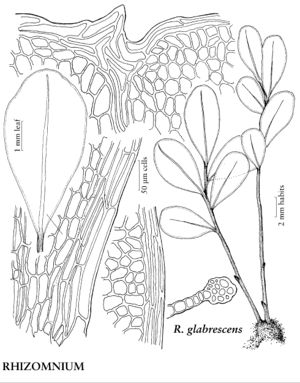Difference between revisions of "Rhizomnium glabrescens"
Ann. Bot. Fenn. 5: 143. 1968.
FNA>Volume Importer |
imported>Volume Importer |
||
| (One intermediate revision by the same user not shown) | |||
| Line 59: | Line 59: | ||
|publication year=1968 | |publication year=1968 | ||
|special status=Endemic;Illustrated | |special status=Endemic;Illustrated | ||
| − | |source xml=https:// | + | |source xml=https://bitbucket.org/aafc-mbb/fna-data-curation/src/2e0870ddd59836b60bcf96646a41e87ea5a5943a/coarse_grained_fna_xml/V28/V28_382.xml |
|genus=Rhizomnium | |genus=Rhizomnium | ||
|species=Rhizomnium glabrescens | |species=Rhizomnium glabrescens | ||
Latest revision as of 21:35, 5 November 2020
Plants (1–)2–3 cm. Stems reddish brown, brown, or black when old; micronemata absent. Leaves green to dark green, slightly contorted and somewhat undulate when dry, obovate or elliptic, (2.5–)4.5–6 mm; margins green or sometimes reddish or brownish, 2–4-stratose; apex rounded or occasionally obtuse or retuse, short-apiculate; costa subpercurrent or percurrent; medial laminal cells short-elongate, sometimes elongate or ± isodiametric, (35–)45–60(–70) µm, weakly or not collenchymatous, walls pitted; marginal cells linear, in 3–4(–5) rows. Sexual condition dioicous. Seta (2–)3–5 cm. Capsule oblong or cylindric, 3–4.5 mm; operculum conic-apiculate or conic-rostrate; exostome greenish yellow, lamellae 18+. Spores 30–45 µm.
Phenology: Capsules mature summer.
Habitat: Forests, logs or tree bases, moist soil near streams, thin soil over shaded rock
Elevation: low to moderate elevations
Distribution

B.C., Alaska, Calif., Idaho, Oreg., Wash.
Discussion
Rhizomnium glabrescens, common in coastal forests along the west coast, is small but distinctive. Male plants are characterized by rosettes of large leaves at the tops of the nearly naked stems. Small, scalelike leaves are present along the stem below the upper rosette. The stems of female and sterile stems have relatively large leaves. Sterile stems often arch, resembling those of Plagiomnium, but are always the same length or shorter than the fertile stems.
Selected References
None.
